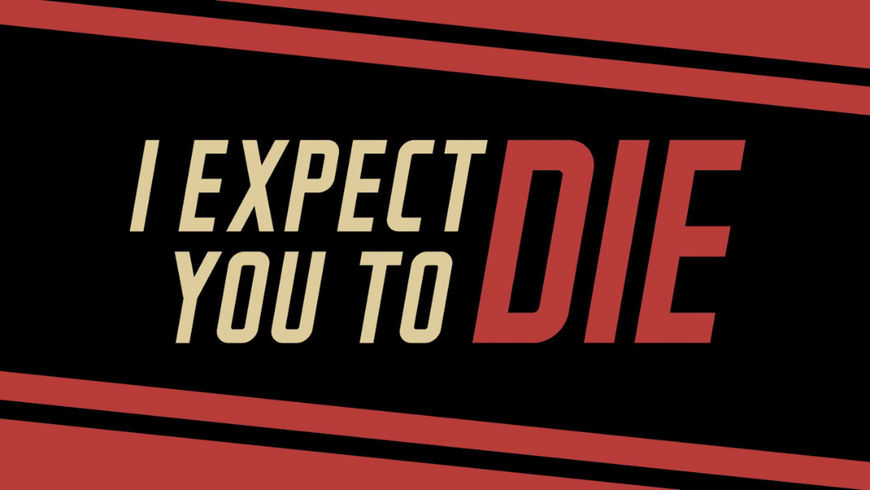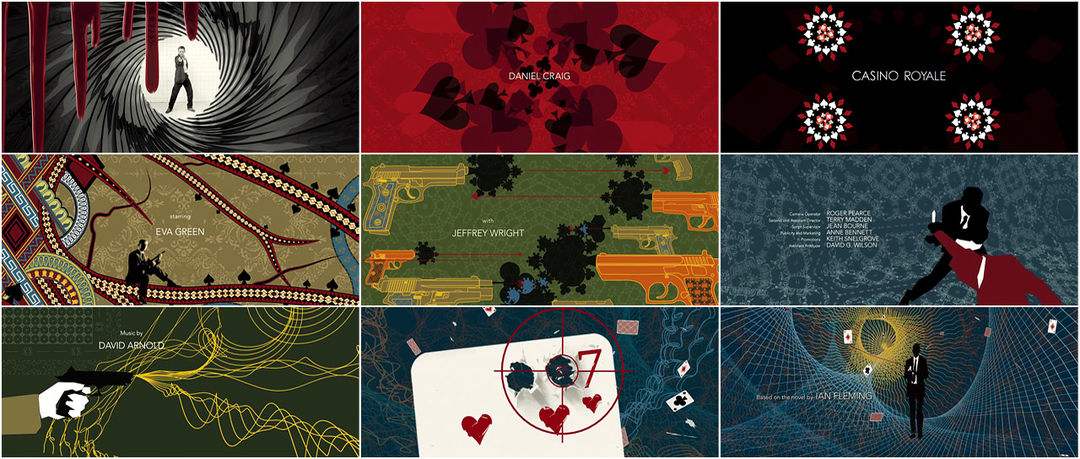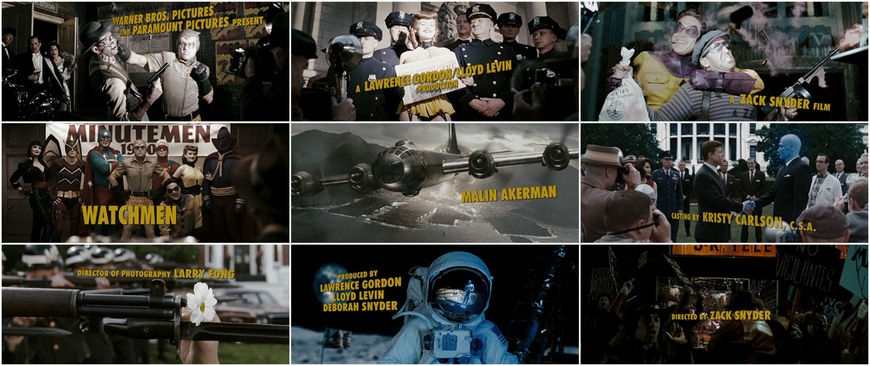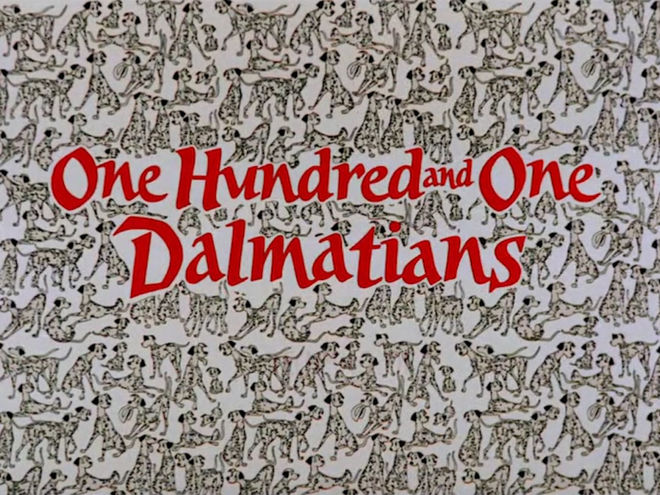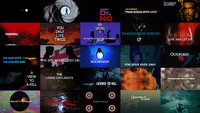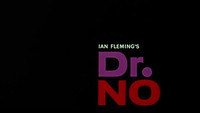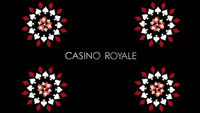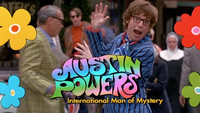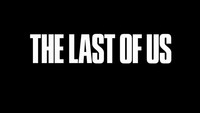She expects you to die. Frequently and unpleasantly, over and over, in all manner of terrible, horrible ways. You’ll be blown up, drowned, burned by lasers, gassed, killed by your own clumsiness or the heinous traps of Dr. Zor. Maybe both. It’s right there in the theme song!
This is your fate in I Expect You to Die, an innovative virtual reality puzzle video game from Pittsburgh-based developer Schell Games. It’s essentially a series of cleverly designed escape rooms couched in the trappings of a classic spy adventure. You play as the ill-fated spook tasked with stopping the evil Zoraxis Corporation from taking over the world, and your chances of success are, well, not great. The game’s title is, of course, a play on the phrase famously uttered by the titular supervillain of 1964’s Goldfinger. It’s as much an homage to the secret agent stories that helped inspire this VR game as it is a warning to players: assume that digital death of some kind is inevitable once you strap on that headset.
But before I Expect You to Die can make good on its promise in earnest, the game’s opening title sequence is there to give players a small taste of what’s in store for them – should they accept this mission. Borrowing a title track and colour palette that could have been ripped from the early 1960s, the sequence pulls the player through a trap-laden evil lair, putting them face to face – virtually – with the many, many things that can and will kill them in the game that follows. Not only is it a tongue-in-cheek sendup of a certain British super spy, it’s an ideal way to introduce players to the dangerous and immersive world of the game.
A discussion with Lead Environment Artist CHRIS CLEVE, Composer TIM ROSKO, and Video Editor JEFF HOFFMAN of Schell Games.
Hi! Could you tell us about your respective roles at Schell Games?
Tim: My name is Tim Rosko. I’m the Audio Designer here and I was the composer of the music for the title sequence.
Chris: My name is Chris Cleve. I’m the Lead Environment Artist here and I did a bunch of the animation in the title sequence.
Jeff: I’m Jeff Hoffman. I’m Schell Games’ Video Editor and I helped out a little bit towards the end of this project with some pre-viz work to figure some of the final shots.
We speak to a lot of filmmakers about title design, so I’m curious to ask a group of game developers this question: what do you feel a title sequence should do? What do you see its function as?
Chris: In general, one of the things I think that game intro sequences do really well is to create an environment where you have the possibility of interactive storytelling along with the credits. Some good examples are the Uncharted series, which has a lot of story delivered through its opening sequences.
Jeff: When I look for an opening title sequence I like it to excite me. I want it to get me pumped up about what I'm about to play or watch.
I Expect You to Die (2016) gameplay trailer
Tim: Throughout the history of video games a lot of times it’s just been a title screen without a title sequence or intro. One of the reasons we wanted to do this with our project was because we hadn’t seen very many stylized intro sequences in games – especially not in VR – so we had the feeling that maybe it was a little pioneering in that way. [laughs]
So at what point in development of I Expect You to Die did conversations about the opening sequence start?
Chris: This actually started out as a pet project by one of our designers, Connor Fallon. We weren’t planning to do a credit sequence at all. He was kind of doing it in his off time, after hours at work, trying to develop something that might work as an end credits sequence for the game. He was just trying to see what he could do. It was very simple, but after a couple of months of working on it he started showing it to the team and we were like, “there is something here.”
Tim: It was mid-full development when he started doing it in his free time. It came into being in its final state nearing the end of production, which was nicely timed, but it was mid-production when he started to exploring these ideas. He started it in November 2015. That was when he first approached us about the idea for a song.
Chris: Then once we showed it to the VPs and the rest of the team in late December or early January, we mulled it over a little bit and decided that it was something we really wanted to do. We wanted to do it right so we scheduled a full six weeks of production time and got started in late February.
It sounds like it really snowballed. So what was Connor’s original concept for the title sequence and how did you develop it? The influence of a certain British super spy is quite apparent…
Tim: Yeah, I think the most obvious influence was Mr. Bond and the title sequences of those movies. When Connor first approached me about it he was like “OK, so I’m doing this thing but it has to have a theme song! We can’t do this without a theme song. Bond intros always have the song!” That was for sure his strongest influence.
Chris: Casino Royale in particular probably had a lot of influence on what we were doing, just because of the simple colours. A lot of that has to do with VR because the simple colour scheme actually really helps to reduce the amount of motion sickness you had going through this environment.
Casino Royale (2006) main titles, designed by Daniel Kleinman
Chris: Connor was working with a lot of really simple stuff at that point – assets from the game flying past you, basically using the flat shaders – and then when we went into full production we spent the first couple of weeks just playing around with different ideas. I had a thing where a gun flew past you and you spun around and went inside the barrel. We ended up feeling what worked best was this sort of theme park ride through different environments and different ways of you dying.
So the colour scheme was as much a technological concern as it was an aesthetic you were going after, is that right?
Chris: Yeah, it was an aesthetic choice and a technological choice, and it above all it was simple, which meant we could do it with a very small team and not have to spend too much time in production.
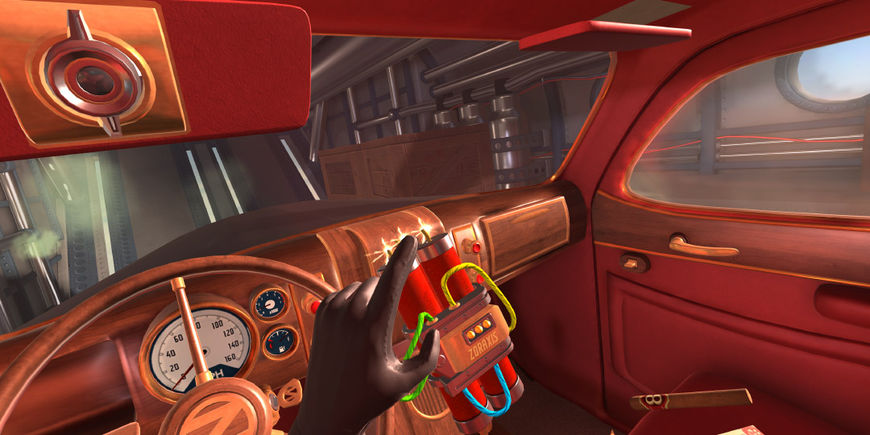
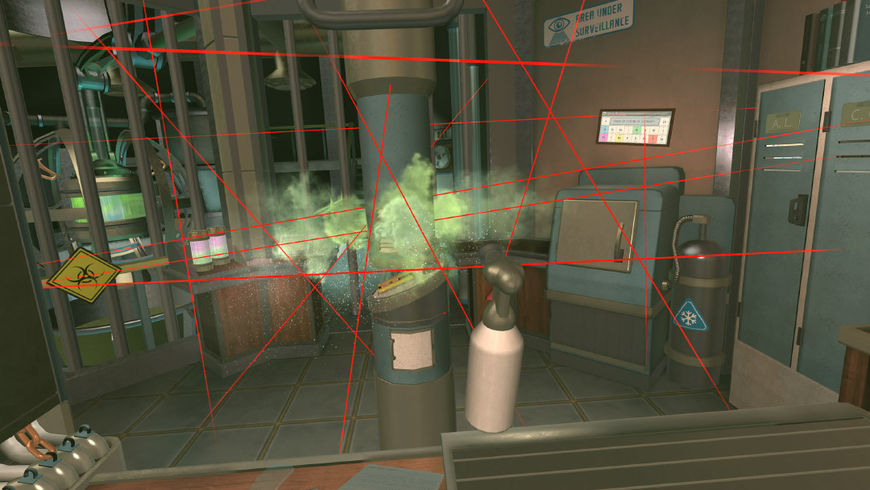
I Expect You to Die (2016) gameplay screenshots
So how was this all conceptualized? You mentioned doing some pre-visualizations, but was Connor storyboarding those early experiments at all?
Chris: I remember seeing it directly in the game engine for the first time...
Tim: He was building it in Unity from the beginning and we were just moving things around.
Jeff: I came in near the end to do the animatics to test out different shots and different ways to execute them without having to spend all that time doing it in-game.
Chris: We would record video and then Jeff would do visual concepting with ideas we had. Then we could decide whether or not we wanted to pursue something and work on the timing to get it right with the song. It was super helpful! It went through a lot of evolutions to be honest. When we first started it was just this short little snippet that could be the intro title, but then it became this larger thing that could be the end credits sequence after you completed the game. It just ended up being such a unique thing that we felt that everybody needed to experience this first.
Designing a sequence like this would be complex enough for a film or TV show, but your team had to design it for an immersive VR game. What sort of challenges did that pose?
Chris: Initially there were some arguments initially about whether we wanted to focus our composition on the player would be looking straight ahead or if there was some way to compose things in a 360° view all around the player so they could see all these things. We ended up with a compromise that was more like 70/30. Most of it was focused straight ahead and we composed things there, but as stuff drifted off to the sides we added stuff in there so there was always something to look at. There’s also some surprises behind you if you’re looking around a whole bunch. At some point it’s almost impossible to compose that much stuff and have it look good all the time, so I think focusing straight ahead for most of it turned out really well.
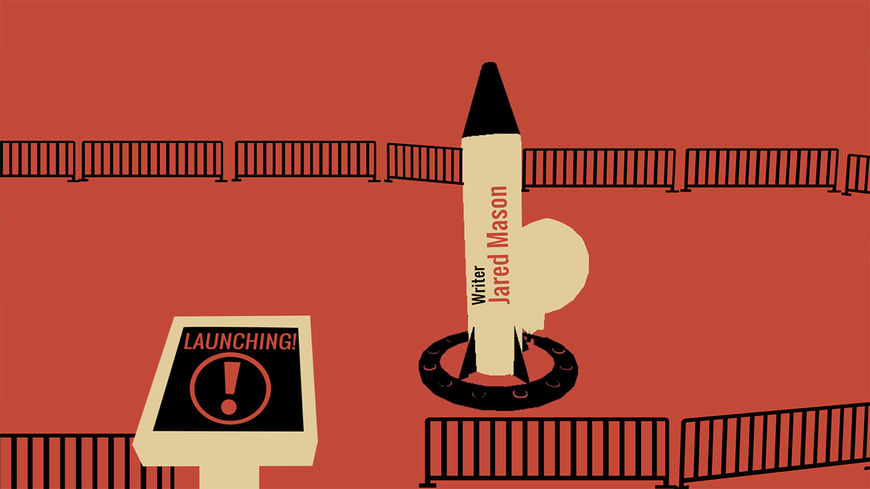
An example of a mock-up used to create the title sequence animatics.
Tim: We also had some heated discussions about whether or not the sequence should be interactive. When you’re in VR – and especially with a game like I Expect You to Die – literally everything you can see in the world you can pick up or interact with in some way. So there was a big discussion about “OK, if it’s around me why can’t I interact with it or touch it?” It ultimately came down to our timeline. Once we had the initial visual flow and the sound finished, we worked to line up the visuals with the timing of the music, that became a separate challenge. When did transitions need to happen? How could we do that in VR as artistically as we could so it would have the most impact?
Chris: The transitions were definitely the biggest payoff we got. We could do all these cool things where you were zooming through the coffin or the rockets were filling up the area with smoke and clouds or going through the “Z” on the bulkhead of the submarine. That 3D motion is the biggest payoff. We found that out right at the beginning so we knew the transitions would be very important.
Obviously you want all your team members to get their due by having the player see their credits, but a common game design problem is getting the player to look where you want them to look when they need to see something. How did you approach this with respect to the game’s title sequence?
Chris: [laughs] Every time I watch somebody play there’s a little pain from them missing some big moment I worked on or tried to get in the game. Somebody will be looking around, see something off to the side, and miss something I wanted them to see in the front! But the nice thing is that people really like the game, so they play through it multiple times and they have all these different things they can notice on each playthrough.
I Expect You to Die (2016) previsualization for an unused segment.
Tim, when did work begin on the theme song and who was involved?
Tim: That started around the same time Connor started working on the initial idea in his spare time. Like I said before, he’d mentioned that every good title sequence needs a good theme song. “We can’t not have that!” The song developed with Connor initially and then over to me and our co-worker Bonnie Bogovich, who was actually the singer on the track. Connor had this idea he’d recorded on his phone and sent to us which became the hook of [singing] “I expect you to die!”
Designer Connor Fallon's early concept for the I Expect You to Die theme song.
Tim: Then Bonnie had an idea based off of that and she started to sing part of the melody.
Audio Lead Bonnie Bogovich sings an early rendition of the theme song.
Tim: There was some back and forth about the lyrics here and there. We wanted it to represent the game but also give it this stylistic treatment. Once we had the basic groundwork of the lyrical concept, I went in and sort of formed it into a full song and a full ballad.
Composer Tim Rosko iterates on early takes of the theme song.
Tim: That was all happening earlier in the process, I guess around November. I remember the first full version of the song from start to finish was in January 2016. It went through various changes after that, tweaking the melody and the performance a bit, but eventually once we’d settled the balance between the song and the visuals, had it synced the way we wanted to and such, we recorded it with live instruments in April. It gave it that final polish!
I imagine composing was a fun process with all the fun 007 songs to reference...

Audio Lead Bonnie Bogovich during the theme song recording session.
Tim: Oh yeah! I remember the recording of the vocals with Bonnie, we had her referencing Shirley Bassey. “Think Shirley Bassey! Really schmaltz it up and be as James Bond-y as you can without being James Bond!” [laughs]
It was a lot of fun coming up with the lyrics and music. I had a playlist of all the James Bond theme songs and was listening to them all day, left and right, pulling from them here and there.
You were also making a game during all of this. How big was the production team for the sequence and what was your workflow?
Chris: The production team was mostly me and Connor doing most of the assets and animation, with concepting help from Jeff and then the audio help from Tim and Bonnie. It was really me and Connor doing all the heavy lifting.
We got together twice a week with the VPs and Jesse Schell, our CEO, and we would just critique the crap out of it, brainstorm for half an hour, and then we’d spend the next two days working on it. We just did that over and over and over again. It was actually a fantastic process.
Tim: I remember there was a point right before we started full production on it where we all realized like, “Oh! This is really cool!” It became very apparent that we wanted to pour as much time and energy into it as we could to making it as good as we could. It was nice to have the VPs on board with that as well. That made it more than just a thing we were working on after hours, it became this thing we wanted to make the best that it could possibly be.
It really is a fantastic way to kick off the game! Is there a particular element or moment in the sequence that is a favourite or that you’re most happy with?
Tim: Decisions! [laughs]
Chris: When I first started out the truck crash at the beginning was probably my favourite. But when I look back on it now, it’s definitely the scene with the coffins! I probably had the most input on that one. The title comes down, we see the coffins, and then they open up perfectly in time with the music. We see the agents inside and they have that symbolism like, “You’re going to die a lot in this game!” [laughs] Then finally you go into the next coffin and fall through it to see those rockets. When those take off the smoke that fills the screen for the next transition is a really awe-inspiring moment. It hits you in the face… literally! Michael Tsai’s smoke effects on that turned out really well.
Tim: There are so many parts of it that are my favourite! I have very specific thoughts because I listened to that song so many times and went through the sequence so many times. But I think my favourite part is the end of the whole song, when you’re in the room with all the generators and you’ve got the lightning bolts and the swinging pendulum blades going across on the cymbal crashes. When we added that to it, that one really got me in VR! [laughs] Everything else felt good, but the swinging pendulums were the first time in the sequence where I felt like “Oh my gosh, I feel unsafe! Those might hit me! [laughs] Those were all really nice because it was fun to time it out. It was gratifying to hear a cymbal crash and see a lightning bolt.
I Expect You to Die (2016) pendulum sequence previsualizations
Jeff: Yeah! That was one of the things I worked on that a little bit. I would say that was my favourite part, but I recall the first time I watched it, the part that stood out for me was the moment where the screen is black and suddenly the black shrinks down and reveals the swirl. Then when you start going into it you realize that the swirl is three dimensional. That’s not something you’re used to going into VR!
Tim: Yeah, that part is cool! I think there was a part where that spiral wasn’t 3D, but then we said “We should be going through that spiral!”
And more generally about this process, was there anything that took you by surprise when working on this sequence?
Tim: I had never written a theme song so on the nose before! I was surprised by how good it felt in the end. I was worried the whole time that it would be cheesy or a little too over the top or something, but in the end I was surprised it worked so well.
Chris: I’ve done a little bit of video editing before, back in college, and a couple of trailers here at Schell before we brought Jeff on. But I was amazed that transitioning from Environment Artist to whatever this mixed title is just how much fun it was. Taking the timing down, getting the animations right so they capture your attention. The process was just a lot of fun and really came to me. It was like riding a bike!
I Expect You to Die (2016) previsualization for an unused ending.
Tim: Another aspect for me was how different it was being in three dimensional space. It’s one thing to watch a video of it – you can get a sense of what’s happening in the title sequence – but when you’re in VR experiencing it, looking around and actually moving through the space, I was surprised by just how visceral it felt.
Chris: We had a lot of critiques in here where someone would be like, “I don’t know if I like the feel of that.” “Well, why don’t you take a look at it in the headset?” Then we’d all venture out, they’d run through it, and be like, “Yeah, don’t change it!” But it could go the other way too, like, “That feels right!” and then you’d get in the headset and it was just not working.
So the process was very iterative based on that raw feedback. And lastly, what are some of your personal favourite title sequences, whether classic or contemporary?
Jeff: I think one of my favourites is a classic one which is the intro to Fight Club. I just love the transition from all this nonsense – you can’t really tell what’s going on other than the credits – and then it pulls out and reveals that you were really small and in his head. It’s the brain with the neurons firing!
Chris: I actually did some research on this one yesterday. It was really hard to narrow it down! For movies, Watchmen has a lot of what we were doing. Text floating through the scenes and slow-mo stuff floating around in 3D space.
Watchmen (2009) main titles, directed by Zack Snyder and designed by Garson Yu.
Chris: If we’re talking video games I think The Last of Us and Borderlands really come to mind. Those games have title sequences with so much character. The Last of Us one is just emotionally devastating!
Tim: For me the first ones that come to mind – this is very classic – is 101 Dalmations. I don’t know why it sticks out, but I remember seeing that one as a kid and I remember the title sequence specifically for whatever reason. I think it’s because it was so jazzy and the visuals are bouncing around to the music. Very similar to that one is the Monsters, Inc. intro. I really enjoyed that one as well. The stylization, the animation with the doors and all the monsters.
101 Dalmatians (1961) main titles
Tim: I also totally forgot this until now, but I love the Game of Thrones intro. That one just gets me psyched!
Chris: I read the books years ago and I remember flipping back to the maps constantly trying to figure out where these things were happening. Then the TV series came out and they did that and I was just like “Yes!”
Tim: And then they update it. Ahhhh! It’s on fire now!
It’s interactive for sure, but not quite as interactive as what your team has created. Thanks for your time everyone!





